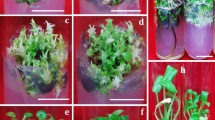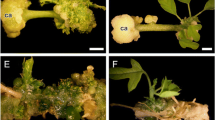Abstract
Selaginella, an extant genus of primitive vascular plants, has survived over 400 million years of evolution. In vitro morphogenesis in Selaginella microphylla is considered for the first time to establish a well-documented aseptic culture on half- strength Murashige and Skoog’s basal medium with 2ip (4.92–49.21 μM), or Kn (4.65–46.47 μM) or GA3 (2.89–28.90 μM) for shoot multiplication, and with different concentrations of IBA (4.9–49 μm) to initiate root cultures. GA3 was instrumental for shoot multiplication as well as induction of reproductive structures in each and every leaf axil. On the other hand, it is observed that IBA alone in S. microphylla can act as signal molecules for induction of enormous numbers of root masses from a few existing roots. An interesting pattern of re-differentiation has also been observed where apical portions of large numbers of roots were converted to green shoot apical meristems. Further differentiation produced tiny green shoots. Distinct bipolarity was noted in shoots when they were isolated from root masses and appeared as embryo-like structures. Chromosome analysis from in vitro sporophytic plants revealed 2n = 16 chromosomes, indicating chromosomal stability. The interesting in vitro pattern of morphogenesis obtained in S. microphylla may provide new insights into totipotency of plants.


Similar content being viewed by others
References
Banks JA (2009) Selaginella and 400 million years of separation. Annu Rev Plant Biol 60:223–238
Banks JA, Nishiyama T, Hasebe M, Bowman JL et al (2011) The selaginella genome identifies genetic changes associated with the evolution of vascular plants. Science 332:960–963
Brian PW (1959) Effects of gibberellins on plant growth and development. Biol Rev 34(1) 37–77
Das NC, Mukhopadhyay R (2006) New record of six species of Selaginella P. Beauv. From Tripura, India. J Bot Soc Bengal 60:9–14
Fleet CM, Sun TP (2005) A DELLAcate balance: the role of gibberellin in plant morphogenesis. Curr Opin Plant Biol 8:77–85
Hegde S, D’Souza L (2000) Recent advances in biotechnology of Ferns. In: Trivedi PC (ed) Plant biotechnology—recent advances. Panima, New Delhi, pp 213–237
King RW, Evans LT, Mander LM, Moritz T, Pharis RP, Twitchin B (2003) Synthesis of gibberellin GA36 and examination of its role in flowering of Lolium temulentum. Phytochemistry 62:72–82
Konar RN, Konar A (1973) Interaction of CCC and gibberellic acid in the morphogenesis of Ranunculus sceleratus tissue in vitro. Phytomorphology 23:105–109
Morel G, Wetmore RH (1951) Fern callus tissue culture. Am J Bot 38(2):141–143
Moshkov IE, Novikova GV, Hall MA, George EF (2008) Plant growth regulators III: gibberellins, ethylenes, abscisic acid, their analogues and inhibitors; miscellaneous compounds. In: George EF et al (eds) Plant PropaGA3tion by tissue culture, 3rd edn, vol 1. The background. Springer, Berlin, pp 227–282
Murashige T (1964) Analysis of the inhibition of or GA3n formation in tobacco tissue culture by gibberellin. Physiol Plant 17:636–643
Murashige T, Skoog F (1962) A revised medium for rapid growth and bioassays with tobacco tissue cultures. Physiol Plant 15(3):473–497
Sah NK, Singh SN, Sahdev S, Banerjee S, Jha V et al (2005) Indian herb Sanjeevani (Selaginella bryopteris) can promote growth and protect aGA3inst heat shock and apoptotic activities of ultra violet and oxidative stress. J Biosci 30:499–505
Setyawan AD (2011) Review: natural products from genus Selaginella (Selaginellaceae). Nusantara Biosci 3(1):44–58
Takamiya M (1993) Comparative karyomorphology and interrelationships of Selaginella in Japan. J Plant Res 106:149–166
Thorpe TA, Meier MD (1973) Effects of gibberellic acid and abscissic acid on shoot formation in tobacco callus cultures. Physiol Plant 29:121–124
Wochok ZS, Sussex IM (1976) Redetermination of cultured root tips to leafy shoots in Selaginella willdenovii. Plant Sci Lett 6:185–192
Wyatt SE, Nicholas C, Carpita NC (1993) The plant cytoskeleton-cell-wall continuum. Trends Cell Biol 3(12):413–417
Yang SF, Chu SC, Liu SJ, Chen YC, Chang YZ et al (2007) Antimetastatic activities of Selaginella tamariscinai (Beauv.) on lung cancer cells in vitro and in vivo. J Ethnopharmacol 110:483–489
Acknowledgments
Authors appreciate help from Prof. S. Jha of Calcutta University and Dr. Nandagopal and Anusree Das in preparation of the manuscript.
Author information
Authors and Affiliations
Corresponding author
Rights and permissions
About this article
Cite this article
Jha, T.b., Mukherjee, S., Basak, A. et al. In vitro morphogenesis in Selaginella microphylla (Kunth.) Spring. Plant Biotechnol Rep 7, 239–245 (2013). https://doi.org/10.1007/s11816-012-0255-y
Received:
Accepted:
Published:
Issue Date:
DOI: https://doi.org/10.1007/s11816-012-0255-y




